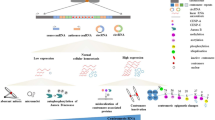Abstract
Human centromeres have been extensively studied over the past two decades. Consequently, more is known of centromere structure and organization in humans than in any other higher eukaryote species. Recent advances in the construction of a human (or mammalian) artificial chromosome have fostered increased interest in determining the structure and function of fully functional human centromeres. Here, we present an overview of currently identified human centromeric repetitive DNA families: their discoveries, molecular characterization, and organization with respect to other centromeric repetitive DNA families. A brief examination of some functional based studies is also included.
Similar content being viewed by others
Author information
Authors and Affiliations
Additional information
Received: 17 March 1997 / Accepted: 14 April 1997
Rights and permissions
About this article
Cite this article
Lee, C., Wevrick, R., Fisher, R. et al. Human centromeric DNAs. Hum Genet 100, 291–304 (1997). https://doi.org/10.1007/s004390050508
Issue Date:
DOI: https://doi.org/10.1007/s004390050508




